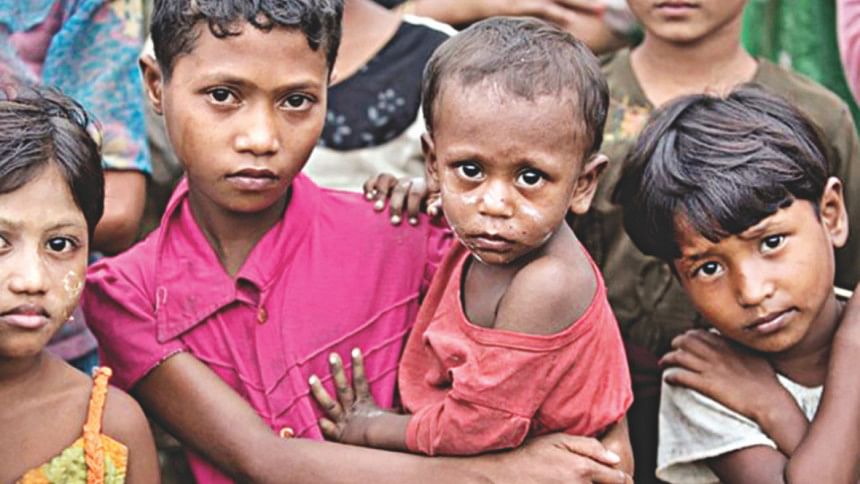Shamble state of Rohingya children

There was an image of persons carrying dead bodies of Rohingya children appearing in the front page of Prothom Alo on September 1, 2017. Recently, Reuters also published a photo of Rohingya children attempting to cross the Bangladesh-Myanmar border fence. They are desperately trying to enter Bangladesh as it appeared in the photo due to extrajudicial killings in the Rakhine region of Myanmar. Utter sense of desperation reflected in both the images. Myanmar and Bangladesh are, however, state parties to the Convention on the Rights of the Child (CRC) and accountable to international communities to ensure protection and humanitarian assistance for refugee children.
“States Parties shall take appropriate measures to ensure that a child who is seeking refugee status or who is considered a refugee in accordance with applicable international or domestic law and procedures shall, whether unaccompanied or accompanied by his or her parents or by any other person, receive appropriate protection and humanitarian assistance in the enjoyment of applicable rights set forth in the present Convention and in other international human rights or humanitarian instruments to which the said States are Parties”, says Article 22 of the CRC. However, there are reports on scores of Muslim Rohingyas — including women and children —being killed by Myanmar security forces and Buddhist vigilantes in a surge of ethnic violence.

However, Bangladesh has been extending support to refugees despite facing resource constraint. Bangladesh has been hosting up to 5, 00,000 Rohingyas for three decades and nearly half of them are children and adolescents. Around 33,000 of refugees are registered and they live in two camps in Cox's Bazar. Although there are basic facilities for children from Rohingya communities in these camps, others live in different areas of Cox's Bazar and Chittagong in a miserable condition. Recent influx of Rohingya children have a severe impact on service provisions in the registered camps and outside locations where refugees reside.
Children from Rohingya communities who are still living in Myanmar are in a shamble state. According to a recent survey conducted by WFP, there are more than 80,000 children in Rakhine State of Myanmar who require support. These children will badly be in need of treatment for acute malnutrition, also known as “wasting,” over the next 12 months, the WFP said. Acute malnutrition develops as a result of recent rapid weight loss or failure to gain weight. If left unaddressed, thousands could be at risk of advancing to a more dangerous stage of malnutrition, which compromises the body's vital processes, and leads to starvation followed by death. According to UNICEF, there are gaps in educational provisions affecting all communities in Rakhine State and it clearly demonstrates lack of investment in basic services.
Furthermore, children are coming in contact with law in a region affected by communal violence. Children as young as 10 years old are among hundreds of Rohingya Muslims detained on charges of consorting with insurgents. According to Reuter, Thirteen juveniles are among more than 400 people arrested since Oct. 9, 2016 when insurgents attacked three police border posts in northern Rakhine State near the frontier with Bangladesh.
“States Parties recognise the right of every child alleged as, accused of, or recognised as having infringed the penal law to be treated in a manner consistent with the promotion of the child's sense of dignity and worth, which reinforces the child's respect for the human rights and fundamental freedoms of others and which takes into account the child's age and the desirability of promoting the child's reintegration and the child's assuming a constructive role in society” says Article 40 of the CRC. Although Myanmar ratified international conventions that require additional protections for children accused of crimes, there are compliance issues for children coming in contact with law. It is not clear whether all provisions, such as whether juveniles have been able to communicate with their families or to have legal representation, were being followed.

To sum up, best interest of the children from Rohingya communities must be considered not only by authorities of Bangladesh and Myanmar, but international community as well. “States Parties shall take all appropriate measures to ensure that the child is protected against all forms of discrimination or punishment on the basis of the status, activities, expressed opinions, or beliefs of the child's parents, legal guardians, or family members” Article 2(2) of CRC categorically says. International community must come forward and act promptly so that children from Rohingya community don't suffer due to activities, expressed opinions, or beliefs of their parents.
The writer is a human rights worker.

 For all latest news, follow The Daily Star's Google News channel.
For all latest news, follow The Daily Star's Google News channel. 



Comments